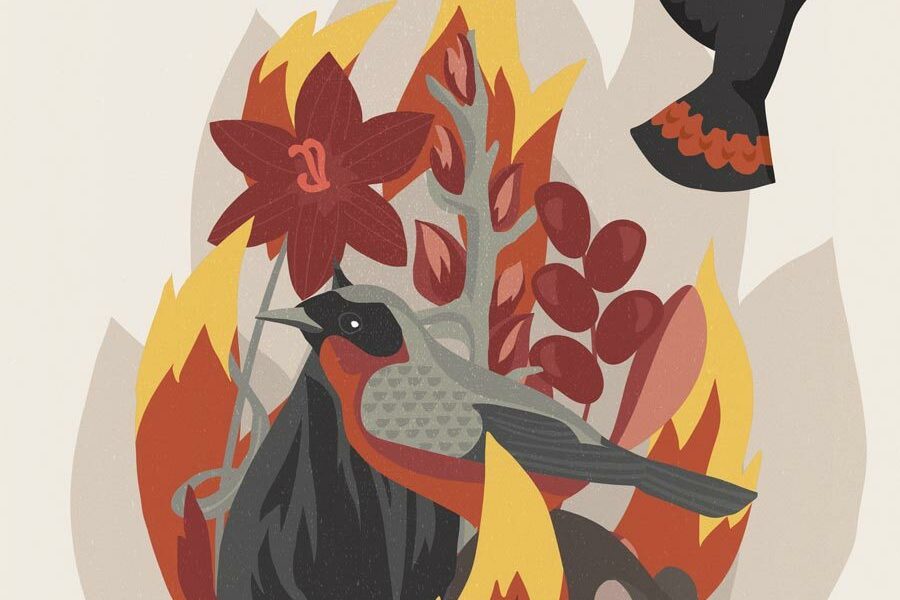The Language of Extinction
When wildfires destroy habitats, more than species are lost.
Holly Haworth

It is often the case now that we do not know of an animal’s or insect’s or plant’s existence — do not ever hear its name — until it is almost gone.
When that species lives across the globe from where we live, this is, in one sense, not surprising. And still, it’s strange that language travels this way, the names of things populating faraway tongues for the first time at the moment they are disappearing. Such was the case this winter when I obtained a list published by the Australian Department of Environment and Energy of vulnerable, endangered and critically endangered species whose habitats have diminished since the bushfires began in July 2019. The fires had spread red on the maps, red on the aerial news cameras, as I watched from afar in horror in the midst of winter in the United States, a winter that hadn’t yet made me shiver until I saw the summer flames engulfing the Australian continent, and the images of koalas and kangaroos trying to escape the blazes.
I also wanted to know the names of living beings that weren’t mentioned on the news; I had never heard of the more than 330 species that filled the list. The names alone — to say nothing of the lives of the things in their various habitats — are a poem, the entire bulk of which would not fit here. I felt compelled to read them aloud:
spectacled monarch, magenta lilly pilly, spiral sun-orchid, austral toadflax, shrubby hazelwood, grey-headed flying-fox, glossy black-cockatoo, long-nosed potoroo, Wallum leek-orchid, Wollumbin dogwood, Booroolong frog, marble daisy-bush, regent honeyeater, satin flycatcher, satin-top grass, velvet wattle, milky silkpod, pale golden moth …
For 114 of the species, the report stated, more than half their known habitat has been damaged by fire. As I said their names, I imagined the list not only as a poem but as a roster, with fewer and fewer answering “here.”
It is not lost on me that almost all the names of the species are given in English, the language I write and speak in, and Australia’s dominant language. The inhabitants of the continent once spoke roughly 250 different languages with 800 distinct dialects, Rhonda Smith at the Australian Institute of Aboriginal and Torres Strait Islander Studies tells me; now there are only 13. What names were these insects and plants and animals called in the 800 dialects? And what living things were lost entirely along with the people who shared a habitat with them?
The sweeping flames seem to mirror the way one worldview — that of domination and extraction — has engulfed the globe, leaving behind cultural homogeneity, what environmentalist Vandana Shiva calls “monoculture of the mind.”
The modern industrial and capitalist mindset pits human culture against nature, and the conservation movement, with different intentions, has tended to do the same. But a wave of anthropological and biological scholarship since the 1990s has made it clear that cultural diversity and biological diversity are intertwined. One study, for example, shows 70% of the world’s languages are found “within the planet’s biodiversity hotspots.” A proliferation of life goes hand in hand with a richness of human language, story, song and oral histories, all of which serve as vessels in indigenous cultures for the complex ecological knowledge needed for good land management. That there is no word for “nature” in indigenous languages the world over indicates the degree to which indigenous people have seen their cultures as interwoven with their living habitats.
Though fire is the source of the destruction in Australia, the tragedy has compelled indigenous people across the continent to share their cultural stories about how fire has been used to nurture biodiversity since before European colonization, before indigenous fires, songs and stories began to be suppressed.
“Our ancestors managed this landscape for millennia and fire was one of our [principal] management tools,” writes Oliver Costello, of the Bundjalung people, in an article for The Guardian’s IndigenousX series. “Through colonization we have seen a rapid decline in our practices and, equally, a rapid decline in the values associated with this country,” Costello writes.
Controlled burning removes vegetation that is more likely to worsen wildfires; it encourages new growth and avoids burning the canopy. “In traditional times, you would’ve been punished for [burning the canopy],” former firefighter and member of the Wiradjuri people, Den Barber, tells Earther. “If you’re burning the canopy, you’re burning not only the shade that the trees offer, but you’re burning perhaps the seedbed. You’re burning habitat. You’re burning flowers. That’s where all the magic is, where all the things that sustain us are.”
The canopy is where the birds sing, another language in itself. Birds can fly away in managed fires, but in large wildfires, they become disoriented by smoke and flames. They die, their lilting songs going with them.
In his book Cultures of Habitat: On Nature, Culture, and Story, ethnobiologist Gary Paul Nabhan writes of how the Warlpiri people of Australia’s Tanami Desert once hunted an animal they called mala, a marsupial weighing less than five pounds. “[The Warlpiri] did not eat them into extinction,” writes Nabhan. They managed their habitat with controlled burning. Nabhan quotes a naturalist who explained the burning practice to him:
Aboriginal fire created a mix of old and new vegetation, and therefore of shelter and food. … The mala’s well-being is very much governed by the right kind of fire. The patchiness of aboriginal burning leaves part of the vegetation untouched. Clumps of old spinifex provide the mala with its shelter, from which it moves to new growth to feed on the seed heads and young leaves of forbs and grasses.
But with colonization came the disconnection of Warlpiri from their land, fire suppression and rabbits — an introduced species that took over the habitat. When the mala began to disappear, Nabhan writes, so did what is known as its Dreaming tradition — the rituals of songs and stories performed for the mala were stopped. A terrible silence. And then the mala were gone from the continent.
While fires raged uncontrolled this past winter, sweeping at 60 miles per hour across the continent, they once were lit with careful precision, small fires licking at the little mounds of vegetation, kindled with knowledge of each unique habitat across the country, where the 250 languages and 800 dialects were used to speak of them. The insects, plants and animals on my list are only the ones that have survived colonization and the disruption of their homes, as the 13 languages have survived the same.
And still, they survive. Native voices are still speaking. Malarndirri McCarthy, senator of Australia’s Northern Territory, said in a speech responding to the wildfires that fire “runs through all aspects of [First Nations] lives, our spirituality and the way we interact with the ecology, and it has done so for many thousands of years. … It’s knowledge that we so want to share.” And many in the country seem to be ready to receive it. Since 2007, Australia’s Indigenous Ranger program has recognized the value of traditional knowledge for conservation. More than 2,000 First Australians now manage the country’s Indigenous Protected Areas to protect biodiversity on more than 166 million acres of land and waters. These rangers are working harder than ever to bring back traditional burning.
In a New York Times article, Alexis Wright, professor of Australian literature at the University of Melbourne and member of the Waanyi nation, spoke with Murrandoo Yanner, a Gangalidda leader who runs the Jigija Indigenous Fire Training Program. “If we can understand, learn from and imagine our place through the laws and stories of our ancestors … then we will have true knowledge on how to live, adapt and survive in Australia, just as our ancestors did,” Yanner said.
Yet, the ancestors did not face climate change and its increase of drought and fire.
In a Cherokee story I have heard from the original inhabitants of the place I am from — the Smoky Mountains, some of the world’s most diverse temperate forests, which saw unprecedented wildfires blazing the ridges in 2016 — the animals decide to steal fire from a lightningstruck sycamore tree because they are cold. When Känäne’skï Amai’yëhï, the Water Spider, finally gets it for them, they gather around it, grateful.
That humans could wield fire and control it made us unique and helped us survive. The ability to cook our food may be what made us intelligent enough to drill into the earth for the fuel of ancient fossilized forests. But when we lit fossil fuels on fire, our population skyrocketed and the world changed. Now it’s getting hotter each day, due to the warming caused by the billions of fires in our gas furnaces, coal plants and combustion engines. All these fires have led to a world now suffering from more uncontrollable fire, wild fire.
“Consciousness is kin to fire,” Christopher Camuto writes in Another Country: Journeying Toward the Cherokee Mountains, and I imagine the first stories of our origins told around the fire, flames leaping across the face of storytellers and dancing at the edges of the night. Now we sit around a different fire with a different story on our lips — not of origins but of the ends of so many things. We’re not cold anymore. The animals once contrived to steal fire to warm themselves, but now they are running from it. If fire is kin to consciousness, then humankind is more conscious than ever of the role we have played in this catastrophe, of how much our stories, whether of domination and extraction or of stewardship and care, matter.
If fire is kin to consciousness, our imaginations must be sparked greater than ever before, and faster, by these large blazes — in order that we might remember how to wield fire consciously, so that our stories, our names for animals, insects and plants, might still be spoken. So that the languages of all the living things might still be heard.




